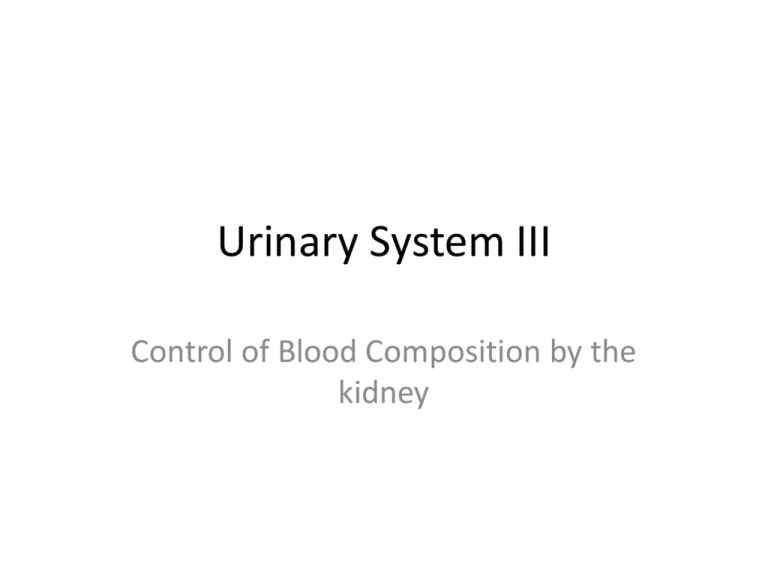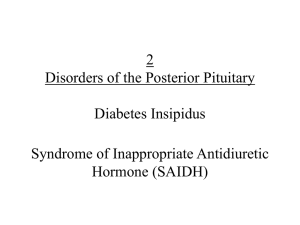Urinary System III
advertisement

Urinary System III Control of Blood Composition by the kidney Blood Composition • • Blood composition depends on 3 major factors: Diet Cellular metabolism Urine output In general, the kidney have 4 major roles to play, which help keep the blood composition relatively constant: 1. Excretion of nitrogen-containing wastes 2. Maintaining water 3. Maintaining electrolyte balance 4. Ensuring proper blood pH Excretion of Nitrogen-containing Wastes • Important nitrogenous wastes found in blood: Urea, Uric Acid and creatinine - Urea: is formed by the liver when amino acids are used to produce energy; it is an end product of protein breakdown Excretion of Nitrogen-containing Wastes - Uric Acid: is released when nucleic acids are metabolized - Creatinine: is associated creatine metabolism in muscle tissue Maintaining Water and Electrolyte Balance of Blood • - Water weight: Male: 60% Female: 50% Babies: 75% This is because females have relatively less muscle and a larger amount of body fat (fat contains least water out of all body tissues) Fluid compartment • Water occupies 3 main locations within the body: Intracellular fluid volume: Fluid that is contained within the living cells 40% of body weight Extracellular fluid volume: includes all the body fluids located outside the cells 20% of body weight a. Interstitial fluid: Fluid between cells and tissues; 80% of ECF b. Blood plasma fluid: 20% of ECF Electrolyte Balance • The proper concentrations of the various electrolytes must be present in both intracellular and extracellular fluids: - Most electrolytes enter the body in foods and “hard” (mineral rich) water - The major factor regulating the electrolyte composition of body fluids is the kidneys Hormones: ADH • Reabsorption of water and electrolytes by the kidneys is regulated by hormones: - Antidiuretic hormone (ADH): Prevents excessive water loss in the urine a. Anti: against / Diuretic: flow of urine from the kidney b. Target: collecting ducts of the kidneys, where it causes the duct cells to reabsorb more water c. ADH is released more or less continuously unless the solute concentration of the blood drops too low Hormone: Aldosterone - Aldosterone: helps to regulate blood composition and blood volume by preventing excessive water loss in the urine: a. Stimulates kidney tubule cells to reabsorb more sodium ions b. Water follows the salt back into bloodstream Maintaining acid-base balance • For the cells of the body to function properly, blood pH must be maintained between 7.35 and 7.45 • Alkalosis: When the pH of the blood rises above 7.45 • Acidosis: when the pH of the blood fall below 7.35 Characteristics of Urine • Freshly voided urine is generally clear and pale to deep yellow - The normal yellow color is due to urochrom, a pigment that results from the body’s destruction of hemoglobin • When formed, urine is sterile and its odor is slightly aromatic - If it is allowed to stand, it takes on an ammonia odor caused by bacterial action Characteristics of Urine • - Urine pH is usually slightly acidic (around 6): A diet rich in protein can cause acidic urine A vegetarian diet can cause basic urine Bacterial infection of the urinary tract also may cause the urine to be basic • Urine is more dense than distilled water





